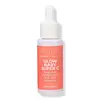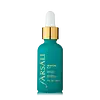What's inside
What's inside
 Key Ingredients
Key Ingredients

 Benefits
Benefits

 Concerns
Concerns

 Ingredients Side-by-side
Ingredients Side-by-side

Water
Skin ConditioningAscorbic Acid
AntioxidantGlycerin
HumectantCetyl Alcohol
EmollientSqualane
EmollientHelianthus Annuus Seed Oil
EmollientTocopheryl Acetate
AntioxidantStearyl Alcohol
EmollientGlycolipids
Skin ConditioningGlyceryl Stearate Citrate
EmollientGlyceryl Laurate
EmollientTocopherol
AntioxidantBoswellia Serrata Resin Extract
SmoothingTerminalia Ferdinandiana Fruit Extract
AntioxidantAlgin
MaskingBisabolol
MaskingGlyceryl Stearate
EmollientSodium Phytate
Xanthan Gum
EmulsifyingPhenoxyethanol
PreservativeSodium Riboflavin Phosphate
Skin ConditioningEthylhexylglycerin
Skin ConditioningWater, Ascorbic Acid, Glycerin, Cetyl Alcohol, Squalane, Helianthus Annuus Seed Oil, Tocopheryl Acetate, Stearyl Alcohol, Glycolipids, Glyceryl Stearate Citrate, Glyceryl Laurate, Tocopherol, Boswellia Serrata Resin Extract, Terminalia Ferdinandiana Fruit Extract, Algin, Bisabolol, Glyceryl Stearate, Sodium Phytate, Xanthan Gum, Phenoxyethanol, Sodium Riboflavin Phosphate, Ethylhexylglycerin
Water
Skin ConditioningMethyl Methacrylate Crosspolymer
Dimethicone
EmollientPropanediol
SolventGlycerin
HumectantDimethicone/Vinyl Dimethicone Crosspolymer
Skin ConditioningCoco-Caprylate/Caprate
EmollientSqualane
EmollientEthyl Macadamiate
Skin ConditioningCetearyl Isononanoate
EmollientPhenoxyethanol
PreservativeCeteareth-20
CleansingCetearyl Alcohol
EmollientHydroxyethyl Acrylate/Sodium Acryloyldimethyl Taurate Copolymer
Emulsion StabilisingGlyceryl Stearate
EmollientAscorbic Acid
AntioxidantEthylhexylglycerin
Skin ConditioningTocopherol
AntioxidantPolysorbate 60
EmulsifyingSorbitan Isostearate
EmulsifyingSodium PCA
HumectantChamomilla Recutita Flower Extract
MaskingTerminalia Ferdinandiana Fruit Extract
AntioxidantCaprylic/Capric Triglyceride
MaskingSodium Citrate
BufferingPhragmites Karka Extract
Skin ConditioningPoria Cocos Extract
Skin ConditioningCitric Acid
BufferingBenzoic Acid
MaskingCeteareth-12
EmulsifyingCetyl Palmitate
EmollientSodium Benzoate
MaskingMalic Acid
BufferingCucumis Sativus Fruit Extract
EmollientWater, Methyl Methacrylate Crosspolymer, Dimethicone, Propanediol, Glycerin, Dimethicone/Vinyl Dimethicone Crosspolymer, Coco-Caprylate/Caprate, Squalane, Ethyl Macadamiate, Cetearyl Isononanoate, Phenoxyethanol, Ceteareth-20, Cetearyl Alcohol, Hydroxyethyl Acrylate/Sodium Acryloyldimethyl Taurate Copolymer, Glyceryl Stearate, Ascorbic Acid, Ethylhexylglycerin, Tocopherol, Polysorbate 60, Sorbitan Isostearate, Sodium PCA, Chamomilla Recutita Flower Extract, Terminalia Ferdinandiana Fruit Extract, Caprylic/Capric Triglyceride, Sodium Citrate, Phragmites Karka Extract, Poria Cocos Extract, Citric Acid, Benzoic Acid, Ceteareth-12, Cetyl Palmitate, Sodium Benzoate, Malic Acid, Cucumis Sativus Fruit Extract
Ingredients Explained
These ingredients are found in both products.
Ingredients higher up in an ingredient list are typically present in a larger amount.
Ascorbic Acid is is pure Vitamin C. This form makes up the largest amount of vitamin C found naturally in our skin.
Not only is vitamin C great for your overall health and immune system, it also has plenty of benefits on your skin.
Vitamin C is best used for brightening skin. It improves dark spots, acne scars, and hyperpigmentation. This is because it blocks the process of skin darkening when exposed to UV.
Remember: Vitamin C should not replace sunscreen!
Your skin uses vitamin C to build collagen. Collagen is one key component in having a strong skin barrier and plump skin. Vitamin C also plays a role in regulating collagen, thus making it effective in improving wrinkles and fine lines.
Ascorbic acid shows potent antioxidant activity. As an antioxidant, it helps fight free-radicals. Free-radicals are molecules that may damage your skin cells. These antioxidants also protect skin against UV damage.
The best formulations include Vitamin E and/or ferulic acid. These two ingredients help stabilize and provide a boost in the benefits of ascorbic acid. This is because ascorbic acid becomes unstable when exposed to UV and air. In fact, you can tell your ascorbic acid has oxidized when it turns an orange-yellow color.
Ascorbic acid is generally compatible with other ingredients. However, using ascorbic acid with other active ingredients might cause irritation. Two ingredients: copper ions and benzoyl peroxide, will inactivate ascorbic acid completely.
Read more about other types of Vitamin C:
Foods rich with vitamin C include oranges, strawberries, broccoli, bell peppers, and more. When consuming Vitamin C, your skin receives a portion of the nutrients.
Learn more about Ascorbic AcidEthylhexylglycerin (we can't pronounce this either) is commonly used as a preservative and skin softener. It is derived from glyceryl.
You might see Ethylhexylglycerin often paired with other preservatives such as phenoxyethanol. Ethylhexylglycerin has been found to increase the effectiveness of these other preservatives.
Glycerin is already naturally found in your skin. It helps moisturize and protect your skin.
A study from 2016 found glycerin to be more effective as a humectant than AHAs and hyaluronic acid.
As a humectant, it helps the skin stay hydrated by pulling moisture to your skin. The low molecular weight of glycerin allows it to pull moisture into the deeper layers of your skin.
Hydrated skin improves your skin barrier; Your skin barrier helps protect against irritants and bacteria.
Glycerin has also been found to have antimicrobial and antiviral properties. Due to these properties, glycerin is often used in wound and burn treatments.
In cosmetics, glycerin is usually derived from plants such as soybean or palm. However, it can also be sourced from animals, such as tallow or animal fat.
This ingredient is organic, colorless, odorless, and non-toxic.
Glycerin is the name for this ingredient in American English. British English uses Glycerol/Glycerine.
Learn more about GlycerinGlyceryl Stearate is a mix of glycerin and stearic acid.
It is used to stabilize the mixing of water and oil ingredients. By preventing these ingredients from separating, it can help elongate shelf life. It can also help thicken the product's texture.
As an emollient, it helps soften skin and supports barrier-replenishing ingredients.
In cosmetics, Glyceryl Stearate is often made from vegetable oils or synthetically produced.
This ingredient may not be fungal-acne safe
Fun fact: The human body also creates Glyceryl Stearate naturally.
Learn more about Glyceryl StearatePhenoxyethanol is a preservative that has germicide, antimicrobial, and aromatic properties. Studies show that phenoxyethanol can prevent microbial growth. By itself, it has a scent that is similar to that of a rose.
It's often used in formulations along with Caprylyl Glycol to preserve the shelf life of products.
Squalane is an emollient that helps the skin hold onto moisture. It's an oily liquid that occurs naturally in certain types of fish and plant oils.
Because squalane boosts hydration in the skin, it also comes with plenty of benefits: it is an antioxidant and can help fight free radicals and skin damage. Squalane is also found to have a detoxifying effect when applied.
Squalane comes from squalene, which occurs naturally within the sebum of our skin. It is one of the oils our skin produces to keep itself hydrated. Squalane is the hydrogenated version of squalene and has a longer shelf life.
Research shows that squalane is non-irritating (even at 100% concentration).
In general, it's a fantastic ingredient. It does a great job at hydrating the skin, and it's suitable for those with sensitive skin.
The source of squalane may impact malassezia / fungal acne. This is because olive oil derived squalane can contain impurities such as fatty acids and plant waxes. Sugarcane derived squalane is recommended for anyone with malassezia concerns.
Is squalane vegan?
This depends on the source. Squalane can be derived from both plants and animals. Most squalane used in skincare comes from plants.
Please note: the source of squalane is only known if disclosed by the brand. We recommend reaching out to the brand if you have any questions about their squalane.
Read more about squalene with an "e".
Is squalane an oil?
Squalane is often called an oil, but it’s technically not; it’s a hydrocarbon, meaning it’s only made of carbon and hydrogen, unlike true oils which are triglycerides made of fatty acids and glycerol.
The term “oil-free” isn’t regulated, so companies can define it however they want. Some exclude all oils, while others just avoid mineral oil or comedogenic oils.
While some people avoid oils thinking they cause breakouts, the right kind of oil (or oil-like ingredient like squalane) can actually help balance and hydrate your skin. It’s worth testing out simple oils or squalane to see what works best for your skin.
Learn more about SqualaneTerminalia Ferdinandiana Fruit Extract is from the Kakadu plum. The Kakadu plum is native to northern Australia. The Kakadu plum holds the record for having the highest amount of natural vitamin C.
This ingredient is an antioxidant. Antioxidants help fight free-radical molecules. Free-radical molecules are capable of damaging our cells and other genetic material. Antioxidants help stabilize free-radicals and thus may reduce the signs of aging.
The high vitamin C content of Kakadu plum also helps lighten skin. Vitamin C has been shown to block the process of skin darkening that leads to hyperpigmentation.
Kakadu plums have been used by indigenous cultures as medicine to help treat colds and as an antiseptic.
Learn more about Terminalia Ferdinandiana Fruit ExtractTocopherol (also known as Vitamin E) is a common antioxidant used to help protect the skin from free-radicals and strengthen the skin barrier. It's also fat soluble - this means our skin is great at absorbing it.
Vitamin E also helps keep your natural skin lipids healthy. Your lipid skin barrier naturally consists of lipids, ceramides, and fatty acids. Vitamin E offers extra protection for your skin’s lipid barrier, keeping your skin healthy and nourished.
Another benefit is a bit of UV protection. Vitamin E helps reduce the damage caused by UVB rays. (It should not replace your sunscreen). Combining it with Vitamin C can decrease sunburned cells and hyperpigmentation after UV exposure.
You might have noticed Vitamin E + C often paired together. This is because it is great at stabilizing Vitamin C. Using the two together helps increase the effectiveness of both ingredients.
There are often claims that Vitamin E can reduce/prevent scarring, but these claims haven't been confirmed by scientific research.
Learn more about TocopherolWater. It's the most common cosmetic ingredient of all. You'll usually see it at the top of ingredient lists, meaning that it makes up the largest part of the product.
So why is it so popular? Water most often acts as a solvent - this means that it helps dissolve other ingredients into the formulation.
You'll also recognize water as that liquid we all need to stay alive. If you see this, drink a glass of water. Stay hydrated!
Learn more about Water